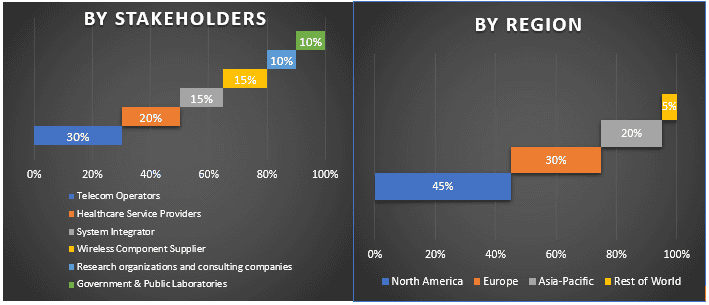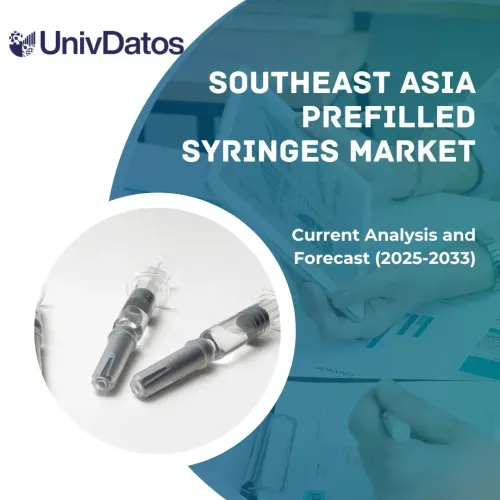- Home
- About Us
- Industry
- Services
- Reading
- Contact Us
Global 5G in Healthcare Market: Current Analysis and Forecast (2023-2030)
Emphasis On Into Component (Hardware, Services, and Connectivity); Application (Connected Medical Devices, Remote Patient Monitoring, AR/VR, Asset tracking for medical devices, and Connected Ambulance); End Users (Healthcare Service Providers, Healthcare Payers, and Other End Users); Region/Country.

The 5G in Healthcare Market was valued at around USD 34.1 BN in 2022 and grow at a strong CAGR of around 40 % during the forecast period 2023-2030. 5G, the fifth generation of cellular wireless technology, has the potential to provide massive connection power and fast speeds that can help transform healthcare delivery. 5G can impact the Internet of Medical Things (IoMT). Also, it will assist in enabling medical innovations by utilizing augmented reality, virtual reality, artificial intelligence (AI), remote medical learning, remote patient monitoring, and much more. Nowadays, it is necessary to get access to near real-time data, as well as to make split-second decisions in healthcare environments, and 5G will provide benefits to this sector in the forecast period. The implementation of 5G in healthcare will lead to better communications with high efficiencies, faster diagnostics at lightning speeds, and transfers of massive files, images, and other content.
Insights Presented in the Report
“Amongst component, the hardware segment holds the major share.”
Based on Component, the market is fragmented into hardware, services, and connectivity. The Hardware segment dominated the market in 2022 and is expected to grow at lucrative growth owing to the need for frequent up-gradation or replacement to make optimal use of the latest software available in the market. Moreover, the rising adoption of new technologies in healthcare and their high implementation drives the demand for hardware. “Amongst applications, connected medical devices segment holds the major share.”
Based on Application, the market is fragmented into connected medical devices, remote patient monitoring, ar/vr, asset tracking for medical devices, and connected ambulance. The Connected Medical Devices segment dominated the market in 2022 owing to the growing inclination towards home healthcare and growth in the telehealth market. According to the renowned Irish-based multinational professional services company, 65% of consumers and 86% of doctors agree that wearables increase patients’ engagement with their health. This engagement is expected to decrease hospital costs by 16% over the next five years.
“Amongst end users, healthcare service providers segment holds the major share.”
Based on End Users, the market is fragmented into healthcare service providers, healthcare payers, and other end users. The Healthcare Service Providers segment dominated the market in 2022 and is expected to grow at lucrative growth during the forecasted period owing to the rising need for an efficient healthcare system, growing patient volume, and an increasing number of hospitals and ambulatory care centers. Moreover, the growth in telehealth, rising adoption of 5G-enabled wearable medical devices, and the rising demand for better technologies that assist in the easy transfer of large data files also drive the market growth.
“Asia-Pacific region signifies one of the largest markets for 5G in Healthcare market.”
For a better understanding of the market adoption of 5G in healthcare, the market is analyzed based on its worldwide presence in the countries such as North America (United States, Canada, and the Rest of North America), Europe (Germany, France, Spain, United Kingdom and Rest of Europe), Asia-Pacific (China, Japan, India, Australia, and Rest of APAC), and Rest of World. Asia-Pacific is expected to dominate the 5G in the healthcare market on account of the presence of a smaller number of vendors. In addition, the significant adoption of advanced technologies, increasing number of IoT-enabled medical devices, continuously enhancing network connectivity, and government initiatives for IoT also drive the market growth in the region. Some of the major players operating in the market include AT&T, Verizon, China Mobile Limited, T-Mobile, Ericsson, Telit, Telus, Vodafone, Nokia, and Samsung. Several M&As along with partnerships have been undertaken by these players to boost their presence in different regions.
5G in Healthcare Market Report Coverage

Reasons to buy this report:
- The study includes market sizing and forecasting analysis validated by authenticated key industry experts
- The report presents a quick review of overall industry performance at one glance
- The report covers an in-depth analysis of prominent industry peers with a primary focus on key business financials, product portfolio, expansion strategies, and recent developments
- Detailed examination of drivers, restraints, key trends, and opportunities prevailing in the industry
- The study comprehensively covers the market across different segments
- Deep dive regional level analysis of the industry
Customization Options:
The 5G in Healthcare market can further be customized as per the requirement or any other market segment. Besides this, UMI understands that you may have your own business needs, hence feel free to connect with us to get a report that completely suits your requirements.
Table of Content
Research Methodology for the Global 5G in Healthcare Market Analysis (2023-2030)
Analyzing the historical market, estimating of the current market, and forecasting the future market of the Global 5G in the Healthcare market were the three major steps undertaken to create and analyze the adoption of 5G in Healthcare for major applications including Connected Medical Devices, Remote Patient Monitoring, AR/VR, Asset tracking for medical devices, and Connected Ambulance. Exhaustive secondary research was conducted to collect the historical market numbers and estimate the current market size. Secondly, to validate these insights, numerous findings and assumptions were taken into consideration. Moreover, exhaustive primary interviews were also conducted, with industry experts across the value chain of the 5G in the Healthcare sector. Post assumption and validation of market numbers through primary interviews, we employed a top-down/bottom-up approach to forecast the complete market size. Thereafter, market breakdown and data triangulation methods were adopted to estimate and analyze the market size of segments and sub-segments to the industry pertains to. Detailed methodology is explained below:
Analysis of Historical Market Size
Step 1: In-Depth Study of Secondary Sources:
A detailed secondary study was conducted to obtain the historical market size of the 5G in Healthcare through company internal sources such as annual reports & and financial statements, performance presentations, press releases, etc., and external sources including journals, news & and articles, government publications, competitor publications, sector reports, third-party database, and other credible publications.
Step 2: Market Segmentation:
After obtaining the historical market size of the 5G in the Healthcare market, we conducted a detailed secondary analysis to gather historical market insights and share for different segments for major regions. Major segments included in the report are component, application, end users, and Region/Country. Further country-level analyses were conducted to evaluate the overall adoption of 5G technology in Healthcare in major region.
Step 3: Factor Analysis:
After acquiring the historical market size of different segments and sub-segments, we conducted a detailed factor analysis to estimate the current market size of 5G in Healthcare. Further, we conducted factor analysis using dependent and independent variables such as the rising adoption of IoT in the healthcare sector and growing patient data.
Current Market Size Estimate & Forecast
Current Market Sizing: Based on actionable insights from the above 3 steps, we arrived at the current market size, key players in the 5G in the Healthcare Market, and market shares of the segments. All the required percentage shares split and market breakdowns were determined using the above-mentioned secondary approach and were verified through primary interviews.
Estimation & Forecasting: For market estimation and forecast, weights were assigned to different factors including drivers & and trends, restraints, and opportunities available for the stakeholders. After analyzing these factors, relevant forecasting techniques i.e., the top-down approach were applied to arrive at the market forecast for 2027 for different segments and subsegments across the major regions. The research methodology adopted to estimate the market size encompasses:
- The industry’s market size, in terms of value (US$) and the adoption rate of 5G technology in Healthcare across the major markets domestically
- All percentage shares, splits, and breakdowns of market segments and sub-segments
- Key players in the 5G in Healthcare market in terms of services offered. Also, the growth strategies adopted by these players to compete in the fast-growing market.
Market Size and Share Validation
Primary Research: In-depth interviews were conducted with the Key Opinion Leaders (KOLs) including Top Level Executives (CXO/VPs, Sales Head, Marketing Head, Operational Head, and Regional Head, Country Head, etc.) across major regions. Primary research findings were then summarized, and statistical analysis was performed to prove the stated hypothesis. Inputs from primary research were consolidated with secondary findings, hence turning information into actionable insights.
Split of Primary Participants in Different Regions

Market Engineering
Data triangulation technique was employed to complete the overall market estimation and to arrive at precise statistical numbers of each segment and sub-segment of the 5G in the Healthcare market. Data was split into several segments & and sub-segments post studying various parameters and trends in the areas of component, application, end users, and Region/Country of the 5G in the Healthcare market.
Main Objective of the 5G in Healthcare Market Study
The current & and future market trends of 5G in Healthcare were pinpointed in the study. Investors can gain strategic insights to base their discretion on investments from the qualitative and quantitative analysis performed in the study. Current and future market trends determined the overall attractiveness of the market at a regional level, providing a platform for the industrial participant to exploit the untapped market to benefit as a first-mover advantage. Other quantitative goals of the studies include:
- Analyze the current and forecast market size of 5G in Healthcare Market in terms of value (USD). Also, analyze the current and forecast market size of different segments and sub-segments of the sector
- Segments in the study include component, application, end users, and Region/Country
- Analyze the value chain involved with the presence of various intermediaries, along with analyzing customer and competitor behaviors pertaining to the industry
- Analyze the current and forecast market size of the 5G in the Healthcare category across the globe. Major regions analyzed in the report include North America (US, Canada, Rest of North America), Europe (Germany, UK, France, Rest of Europe), Asia-Pacific (China, India, Australia, Singapore, Rest of Asia-Pacific), & and Rest of World
- Define and analyze the competitive landscape of the 5G in the Healthcare sector and the growth strategies adopted by the market players to sustain in the fast-growing market
- Deep dive regional level analysis of the industry.
Related Reports
Customers who bought this item also bought










